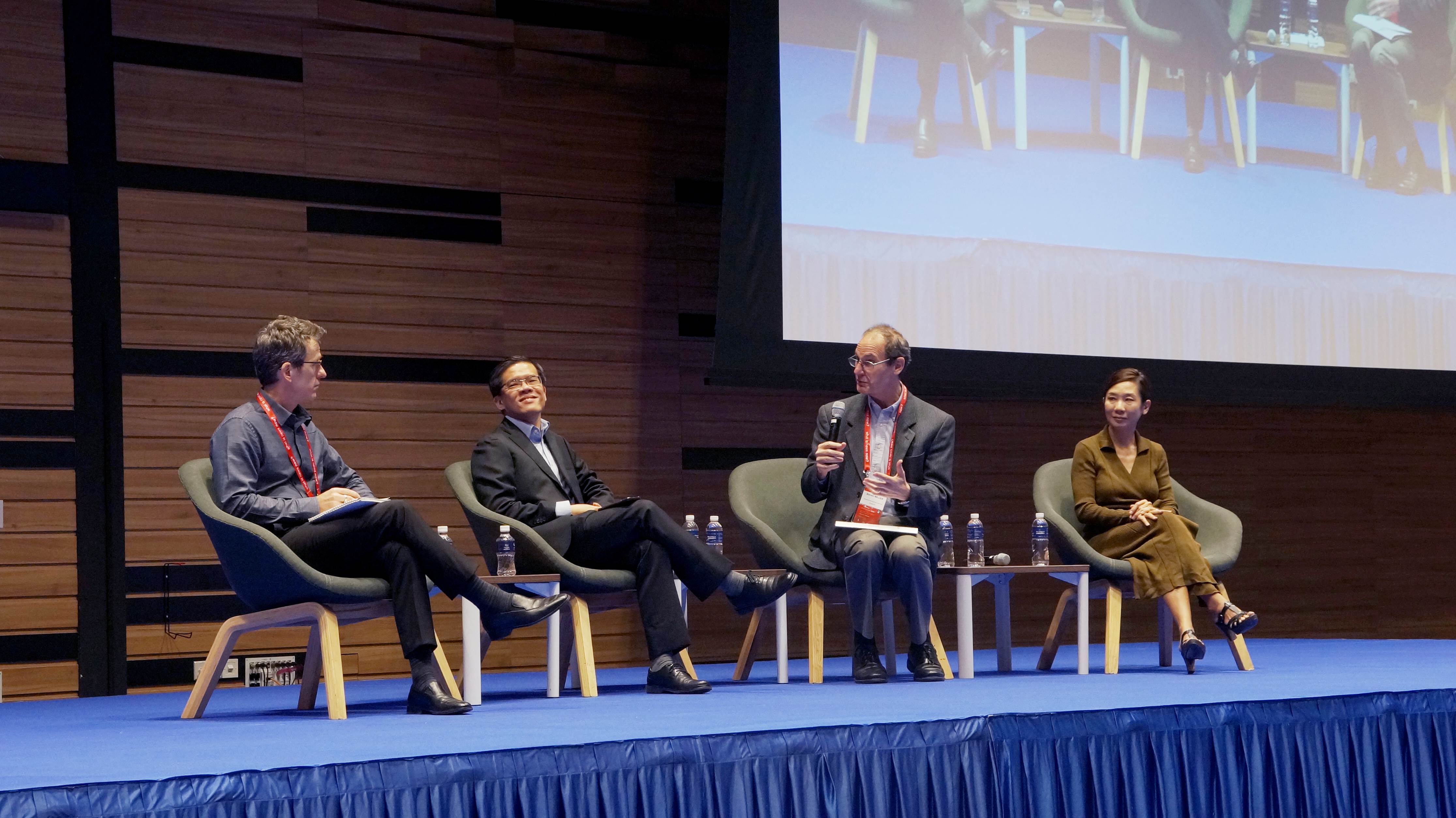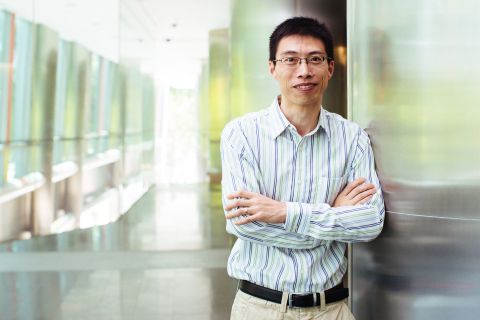
Above (from left): Associate Professor Christopher Zegras, lead Principal Investigator for the Singapore–MIT Alliance for Research and Technology’s Future Urban Mobility Research Group (SMART FM); Mr Kok Ping Soon, Chief Executive of the Government Technology Agency of Singapore (GovTech); Professor Steven Miller, Vice Provost of Research at Singapore Management University; Dr Hee Limin, Director of Research at the Centre for Liveable Cities
By Rebecca Tan
When self-driving vehicle start-up nuTonomy was looking for a place to launch its autonomous taxi trials in 2016, two locations immediately stood out. One of them was Boston, Massachusetts, an understandable choice for the Massachusetts Institute of Technology (MIT) spin-off. But its first choice was the city-state of Singapore, an island located on the other side of the world, one degree north of the equator.
One of the smallest countries in the world in terms of physical size, Singapore is one of the most wired nations in the world, with a mobile penetration rate of 150 percent. And since the country’s Smart Nation initiative was announced in 2014, it has committed considerable resources to taking advantage of this connectivity for the sake of citizens, making it an even more attractive location for innovative ideas.
“We are integrated to an extent that very few other countries are,” said Professor Steven Miller, Vice Provost of Research at Singapore Management University (SMU), speaking at a panel on Singapore’s Smart Nation journey at the East-West Centre International Media Conference held on 24-27 June 2018. “Having the multiplicity of different layers of government under one unified system is helpful and allows us to do special things.”
Small and smart
Indeed, for academics who study urban mobility, Singapore is often held up as the “holy grail”, said Associate Professor Christopher Zegras, lead principal investigator for the Singapore–MIT Alliance for Research and Technology’s Future Urban Mobility Research Group (SMART FM).
“Road pricing, integrated land use transport planning, a very sophisticated and well-informed civil service technocracy – these are part of the magic formula that this nation is so lucky to have. These conditions have enabled SMART FM to experiment ‘on the ground’ with various mobility innovations, including autonomous vehicles,” he said.
Researchers with SMART launched nuTonomy in 2013 and had its first vehicles operating on the streets of Singapore in 2016; the company was later acquired in 2017 by Delphi Automotive (now Aptiv) for US$450 million.
“The beauty of being a small country like Singapore is that we are both a city and a country,” said Mr Kok Ping Soon, chief executive of the Government Technology Agency of Singapore (GovTech). “Being small and integrated, we have the ability to make changes at the policy level and quickly align the policy to the processes, structures and programmes that are in place. We want to be able to use this to our advantage in terms of moving much faster than other cities.”
Transport transformed by technology
Building on its existing advantages due to organisation and political structure, the Singapore government is carefully adopting technology to accelerate its pace of innovation and change. For example, the Land Transport Authority plans to launch a satellite-based electronic road pricing (ERP) system by 2020 for flexible congestion management, a technological upgrade over the existing gantry-based system. This would be the world’s first deployment of this type of system for an entire city.
"It is precisely because technology has moved so fast that we are now able to move to ERP version 2.0,” said Mr Kok. “Similarly, now that transportation and mobility related data is widely available and computing power is so accessible, we are able to use data in privacy protecting ways to be more responsive in our planning of transport routes and services.”
Previously, bus routes were planned using rule-of-thumb experience and estimations based on the limited types of data that were previously available, he continued. These days, however, fare card data, other types of mobility pattern data, and urban planning information on current building and facility locations, as well as plans for new buildings and facilities, is put at the disposal of planners, allowing them to dynamically plan public bus routes and related transportation services.
GovTech has gone one step further to engage passengers and private transport companies in co-creation, making aggregated, anonymized data available for their use, said Mr Kok. One of the outcomes of this open approach is the Beeline app, which allows users to signal their point-to-point transportation needs and the amount they are willing to pay for the ride. If there is enough demand for a particular route, private bus operators like GrabShuttle can step in to offer their services, Mr Kok explained.
“Beeline is an example of how we can aggregate data, make it available for private sector players, and crowdsource the solution to citizens,” he added.
Changing minds, winning hearts
As important as these enabling technologies may be, they are only one part of the equation, said Dr Hee Limin, director of research at the Centre for Liveable Cities, a knowledge centre started by Singapore’s Ministry of National Development and the Ministry of the Environment and Water Resources.
“Our understanding is that a liveable city should not be about using technology for technology’s sake, but about how we apply technology in the city to meet the real needs of citizens and residents,” Dr Hee explained. “We have to see technology as part of a larger slew of measures to get people to change their minds to support more sustainable and more liveable cities.”
Citing the example of Singapore’s ambition to be a car-lite city, Dr Hee said that reducing the number of cars on the roads will require a multifaceted approach that requires using technology to give people more transport options, understanding what it takes to motivate people to make use of these new options, as well as using regulations in thoughtful and creative ways for gradually increasing restrictions on access to privately owned cars.
“We can offer our people in Singapore lots of transportation choices, but people have to come to realize and believe these new choices are actually more convenient, and are good experiences. Most people are practical, and will not change their transportation usage and means of mobility just for an abstract sense of contributing to the greater good of society,” she explained. “We have to change our notion of mobility. We have to better understand how our people view the experience of traveling from one place to another in Singapore when they use car-lite transportation choices that we are increasingly making available. We have to deeply understand these people issues so we can be smart in the way we use these smart transportation technologies.”
Professor Miller added that the key to successfully executing smart city plans rests on getting our Singapore population to re-think some of our fundamental social contract assumptions related to what an individual person might want to do to satisfy their individual interest and desires versus what works sustainably and liveably for the community at large. Everyone benefits if there is less traffic related congestion and pollution, he notes, but that means many people will have to make changes in their mobility behaviours to participate in moving Singapore toward a car-lite ecosystem. “A trusted government that has good relationships with its residents and that can hold the social fabric together is key to nurturing this type of change and transformation. That is the essence of what will enable Singapore to truly transform itself into a people-centric smart nation.”
Back to Research@SMU Issue 58
See More News
Want to see more of SMU Research?
Sign up for Research@SMU e-newslettter to know more about our research and research-related events!
If you would like to remove yourself from all our mailing list, please visit https://eservices.smu.edu.sg/internet/DNC/Default.aspx

